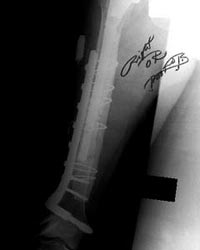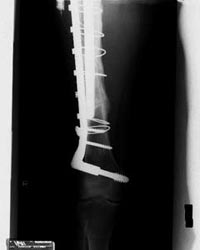Supracondylar plating aids periprosthetic fracture healing
The adjustable angle plate provides mechanical stability for healing, mobility.
Fractures that occur distal to the stem of a hip prosthesis or around it may require revision surgery to implant a longer stem, extensive open reconstruction or both. Often, despite such efforts, refracture occurs beyond the fixation point or distal to the stem of the new prosthesis and the results can be disastrous.
Initial results of open reduction internal fixation of subtrochanteric periprosthetic femoral fractures using a supracondylar cable plate showed the device buttressed the femur to help prevent secondary fractures and promoted early healing, particularly when used with allograft bone. The plate was designed to bridge and stabilize the fracture site and may be used with cables or cerclage wire.
Walter F. Abendschein, MD, clinical professor of orthopedics at Georgetown University School of Medicine in Washington, reported excellent results in the dozen cases in which he has used Biomet’s 316 stainless steel VHS Supracondylar Cable Plate. Most patients were at least 80 years old.
In a telephone interview, Abendschein told Orthopedics Today that the plate fits his philosophy for managing supracondylar fractures: “Treat the whole femur. Go all the way down.” Treating this kind of fracture using a longer plate enabled him to “buttress it all the way to the supracondylar area of the femur.” The plate is available in three lengths (152 mm to 338 mm).
It is also an excellent option when intramedullary fixation is not possible for fractures proximal to the femoral component of a knee prosthesis, he said.
Because the supracondylar cable plate combines integral cable sleeves with a variable angle adjustable from 85º to 110º, it can practically be customized to each patient’s femur.
Customized fit
After selecting the best angle, “The supracondylar screw portion goes across [the femur] at approximately 105º with the entry point in the lateral femur 4 cm above the joint line,” Abendschein said. For a better fit, the plate may be bent. “We then customize it with the adjustment screw, an absolutely unique feature of this device.” Using a worm gear, the surgeon moves and sets the adjustment screw at the desired angle.
In most cases, Abendschein placed cortical onlay strut allograft anteriorly or medially to enhance healing and prevent the cables from cutting through the bone in highly osteoporotic patients.
Most of Abendschein’s patients have been followed two years. “They healed very rapidly, in 10 or 12 weeks easily, which is extraordinary. I’ve been impressed with the early incorporation of the bone grafts,” he said.
Postoperatively, even older patients are quickly mobilized. “I try to keep their weight-bearing limited from 50% to 75% until there’s x-ray evidence of fracture healing. But, quite frankly, most of these people are full weight-bearing, which is another reason to treat the whole femur — to give them as much initial mechanical stability as possible so that they can be mobilized,” Abendschein explained.
There were no infections and no major complications requiring reoperation in the series.
|
Fractures on increase
Abendschein said this plate is a solution to the increasing number of periprosthetic femoral fractures due to the greater numbers of older patients with arthritis or hip fractures undergoing total hip arthroplasty. An estimated 350,000 to 400,000 primary total hip replacements are performed annually.
Periprosthetic fracture risks are also mounting with an older, more active population. “People are still going to go skiing and fall off their horses. When they fall they’re not going to break their implant; they’re going to break their femur,” he said.
Rates of subsequent femoral fracture are 2.9% at five years’ postop, increasing by 5.1% at 10 years’ postop, according to the literature. “No matter how well we’re doing with better cementing techniques and noncemented prostheses, it doesn’t prevent this problem.”
Dr. Abendschein has a financial interest in the VHS Supracondylar Cable Plate and is a paid consultant for Biomet.



